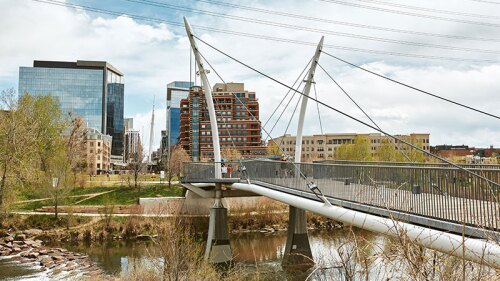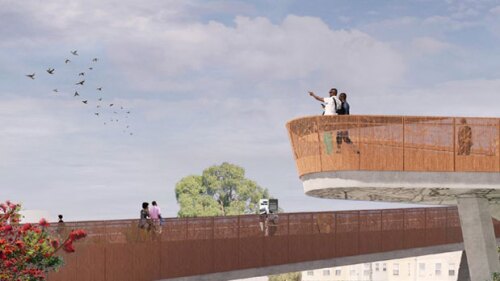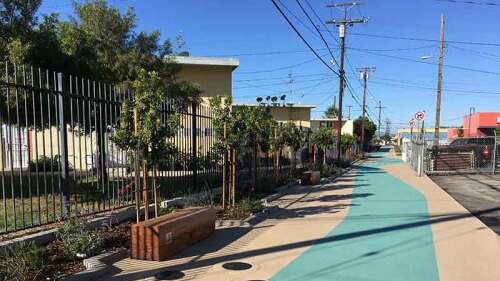Major changes resulted both directly and indirectly from the University of Pennsylvania’s 2004 purchase of a U.S. Postal Service property adjacent to Philadelphia’s 30th Street Station, according to speakers at ULI’s “Place Making 2013: New Drivers, New Partners” conference in June.
“It wasn’t the prettiest gateway to Penn,” Anthony Sorrentino, executive director of public affairs at Penn, said of the two buildings covering 1 million square feet (93,000 sq m), plus 15 acres (6 ha) of surface parking. “But we had long coveted the property. Back in the ’60s and ’70s, we pictured a ring of parking.” By the time the university acquired the property, he said, its vision had become “more modern – to stitch Penn’s campus to the [Schuylkill] River and Center City,” where many Penn faculty and staff members live, commuting to work on foot or by bicycle.
This section of West Philadelphia, now known as the University City District and served by a nonprofit organization of that name, includes both Penn and neighboring Drexel University, as well as two large hospitals – the Hospital of the University of Pennsylvania and Children’s Hospital of Philadelphia. University City provides an example of place making unfolding in the present.
The purchase marked the beginning of Penn Connects, the university’s campus use plan. Rather than wall itself off from the surrounding community as it had tried to do for many years, Penn is seeking to improve interaction with the community through improved access to campus and the creation of public spaces. The plan also gives priority to dense, mixed-use development around the edges of campus, taking advantage of the transportation hubs already in place.
The industrial part of the post office parcel has been transformed into Penn Park – 24 acres (9.7 ha) of green space for sports and recreation. Open 6 a.m. to midnight, its facilities – including tennis courts and a softball field – are available not just to the university community, but also to the public. “There’s an attorneys’ softball league that can’t play during the day, so their games are scheduled for 10 at night,” Sorrentino said.
Penn Park, which was dedicated in fall 2011, together with Shoemaker Green (completed in fall 2012) and Kane Park (dedicated this past June), has increased the amount of open space on campus by 30 percent.
The additional open space is only part of the campus plan. “Penn is a significant builder, with an average capital budget of $150 million annually for constructing academic facilities,” Sorrentino said.
On the edges of campus, Penn between 1997 and 2010 invested $149 million in commercial development, mostly retail and residential projects. Most of this development has been done in partnership with private developers.
One of these developers is Brandywine Realty Trust, Penn’s partner in Cira Centre South, as the repurposed post office buildings have been named. Brandywine also developed the Cira Centre, the first high-rise office building on the west bank of the Schuylkill, which opened in 2006. (The latter building’s architect, Cesar Pelli, was a keynote speaker at the conference.)
The main post office building has been preleased to the U.S. Internal Revenue Service; the annex will serve tenants attracted by tax incentives offered by the Keystone Opportunity Zone Program. On weekdays, the two buildings are expected to bring about 5,000 white-collar workers to the district – people more likely to go out for lunch or for drinks after work than the Postal Service shift workers had been.
Brandywine has shifted its investment emphasis over the past decade, said Gerald Sweeney, company president and CEO. Urban properties once were only a small part of the company’s Philadelphia portfolio; today, they account for about 25 percent, making Brandywine the largest property firm in the city. “We’re looking at the properties as more than just what’s within the walls of the building, but [also] the surrounding environment,” he said. “If properties are well designed and well built, and if they deliver much more outside the envelope, most of them will hold value much better.”
The company is committed to University City: it is also partnering in the Grove, a 33-story student housing complex as part of the Cira Centre complex. The last piece of University City will be the Walnut Street Tower, a mixed-use office and residential building scheduled to be completed at the end of 2014.
Not all of University City’s surrounding environment is directly tied to Penn and the other large institutions. The University City District sponsors various outdoor gathering places, including traditional parks and playgrounds, as well as temporary “parklets.” One new space, the Porch at 30th Street Station, has transformed sidewalks and a parking area into a performance and gathering space. Located midway between Cira Centre and Cira Centre South, its use is expected to increase as more office workers join the University City mix.
Those interested in more information on place making may be interested in purchasing “Place Making: Developing Town Centers, Main Streets, and Urban Villages” from the ULI Bookstore.






